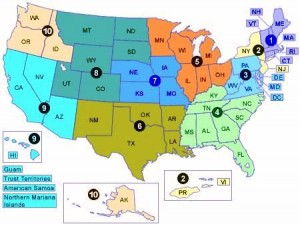
Particulate matter, which comes from factories, power plants and motor vehicles, can cause a number of serious health problems.
U.S. Environmental Protection Agency is designating 31 areas across the country as not meeting the daily standards for fine particle air pollution (PM 2.5), or particulate matter.
Particulate matter, which comes from power plants, factories and motor vehicles, can cause a number of serious health problems, including aggravated asthma, increased hospital admissions and emergency room visits, heart attacks and premature death.
Large areas of California, Connecticut, Michigan, New Jersey, New York and Ohio, among others, are in violation of the standard. Click here for your state.
Particulate matters, or PM, are particles found in the air, including dust, dirt, soot, smoke, and liquid drops. Particles remain in the air for long periods. Some particles are large or dark enough to be seen as soot or smoke, as in diesel truck exhaust. Others are so small that they can only be detected with an electron microscope.
Many man made and natural sources emit particulate matter directly or emit other pollutants that react in the atmosphere to form them. These solid and liquid particles come in a wide range of sizes.
Particles less than 10 micrometers in diameter (PM10) pose a health concern because they are inhaled and accumulate in the respiratory system. Particles less than 2.5 micrometers in diameter (PM2.5) are “fine” particles, and are believed to pose the greatest health risks. Because of their small size (approximately 1/30th the average width of a human hair), fine particles can lodge deeply in your lungs.
EPA estimates that about one out of every three people in the United States is at a higher risk of experiencing PM2.5 related health problems. One group at high risk is active children because they often spend a lot of time playing outdoors and their bodies are still developing. In addition, oftentimes the elderly population is at risk. People of all ages who are active outdoors are at increased risk because, during physical activity, PM2.5 penetrates deeper into the parts of the lungs that are more vulnerable to injury.
A good way to learn about unhealthy exposures is to check daily Air Quality Index forecasts. Visit www.airnow.gov to find the forecast for your area.
The 31 areas, made up of 120 full or partial counties, were designated as “non-attainment” because their 2006 to 2008 air quality monitoring data showed that they did not meet the agency’s health-based standards.
Last December EPA identified attainment and non-attainment areas based on air quality monitoring data from 2005 through 2007.
However, the December 2008 designations were never published in the Federal Register and have been under review. Because the 2008 air quality data is the most recent, EPA used this data to make its final designations.
Using the 2006 to 2008 data, 91 U.S. counties that were identified as non-attainment in December 2008 are now meeting the standards. The new data also showed that four new counties in three states are violating the daily PM 2.5 standards, the annual PM 2.5 standards, or both. EPA will work with these four counties to evaluate air monitoring data and other factors to make final designations by early 2010.
Non-attainment areas include counties with monitors showing violations of the standards and the nearby areas that also contribute to that violation. Affected states and tribes will be required to take steps to reduce the pollution that forms fine particles. The majority of U.S. counties and tribal lands are meeting these standards, but will need to continue working to maintain clean air.
In 2006, EPA strengthened the 24-hour fine particle standards from 65 micrograms per cubic meter to 35 micrograms per cubic meter of air to protect public health.
EPA says that nationwide, monitored levels of fine particle pollution fell 19% from 2000 to 2008. Fine particles can either come directly from power plants, factories, and motor vehicles, particularly diesel trucks and buses, or they can form in the atmosphere from reactions of sulfur dioxide and nitrogen oxides.
